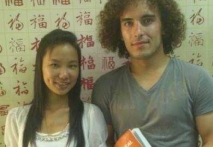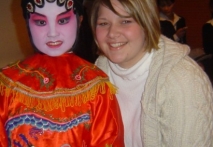学习心得
语风汉语学生Jennifer
学习心得
语风汉语学生Jennifer
我叫Jennifer,我非常喜欢在语风汉语无锡校学习汉语,这是一个非常好的学...
语风汉语无锡校 Zack
学习心得
语风汉语无锡校 Zack
我叫Zack,我是法国人,无锡语风汉教中心是一个学习中国文化和对外汉语的好...
语风汉语学生Kevin
学习心得
语风汉语学生Kevin
语风汉语是一个最理想的学习汉语和中国文化的好地方,学校给我们提供了很多...
语风汉语学生Florent
学习心得
语风汉语学生Florent
我非常喜欢无锡语风汉语学校,这里真的有最简单的汉语学习方法,我学习汉...
语风汉语学生Brad
学习心得
语风汉语学生Brad
我叫Brad,我是澳大利亚人,我再语风汉语学校学习汉语。我现在可以独立和我的...
语风汉语我的无锡学习汉语之路
学习心得
语风汉语我的无锡学习汉语之路
Cherry Queen 中文名: 钱沫以 &nbs...
无锡语风汉语优秀汉语学生Victoria
学习心得
无锡语风汉语优秀汉语学生Victoria
维多利亚Victoria,来自德国的一位11岁的小女孩 ,现读于语...
无锡语风汉语外国学生Michael的汉语学习之路
学习心得
无锡语风汉语外国学生Michael的汉语学习之路
Michael 刚刚来我们无锡语风汉语学校不久的美国学...
苏州汉语学生Jude
学习心得
苏州汉语学生Jude
我叫Jude,在苏州语风汉语学校学习汉语,我也在无锡语风汉语学校学习过很长时间...
无锡语风汉语学校Jessie
学习心得
无锡语风汉语学校Jessie
我学习汉语已经八年了,我能听明白别人说汉语,但是我自己说汉语却觉得说...
汉语 加官方
关注了解更多对外汉语资讯

0510-81151808
1866 1199 988
Sandy.Swun
519988808
无锡新区长江一号 茂业
深茂商务中心8号楼405室
无锡语风学校
语风汉语教学中心
无锡语风国际教育交流中心
Wuxi Mandarin Education School
How to Decorate for Chinese New Year: The Top 7 Decorations

Chinese do most of the decoration for the Spring Festival on New Year's Eve, although people begin to decorate their houses around 10 days before. All decorations involved the colour red and lucky images. 2018 is a year of the Dog, so dog decorations will appear.
1. Chinese Red Lanterns — Drive Off Bad Luck
Chinese lanterns are used in important festivals such as the Spring Festival (Chinese New Year to the Lantern Festival) and the Mid-Autumn Festival.
During Chinese New Year it is not uncommon to see lanterns hung on trees in the streets, office buildings, and doors of houses. Hanging a red lantern in front of the door is believed to drive off bad luck.
2. Door Couplets — Best Wishes for the Coming Year
Chinese Couplets Writing couplets for Spring Festival
New Year couplets (对联duìlián /dway-lyen) are pasted on doors. On the couplets, good wishes or statements are expressed.
New Year good wishes are usually posted in pairs (i.e. couplets), as even numbers are associated with good luck and auspiciousness in Chinese culture. Couplets are brush works of Chinese calligraphy, in black ink on red paper.
The two usually-seven-character lines of the couplet are affixed on the two sides of a doorway. Many are poems about the arrival of spring. Some are statements about what the residents want or believe in, such as harmony or prosperity. These might remain up until renewed at the next Chinese New Year.
In the same vein, a four-character idiom of well wishes is often added to the crosspiece of the door frame as well.
3. Paper Cuttings — Luck and Happiness
Chinese New Year decorations. It is a custom to paste paper cut-outs on windows during the Chinese New Year.
Paper cutting is the art of cutting designs out of paper (any colour, but typically red for the Spring Festival), and then gluing them to a contrasting backing or a transparent surface (e.g. a window). It is customary for people in northern and central China to paste red paper cuttings on doors and windows.
The image of an auspicious plant or animal typically provides the theme of the New Year's paper cutting. Each animal or plant represents a different wish.
For example, the peach symbolizes longevity; the pomegranate, fertility; the mandarin duck, love; the pine tree, eternal youth; the peony, honour and wealth; while a magpie perched on the branch of a plum tree presages a lucky event that will soon happen.
4. New Year Paintings — a Symbol of New Year's Greetings
New Year Paintings (年画niánhuà/nyen-hwaa/) are pasted on doors and walls during the New Year for decorative purposes and as a symbol of New Year's greetings. Images on the paintings are auspicious legendary figures and plants.
5. Upside-Down Fu Characters — Luck 'Poured Out'
Similar to New Year couplets, and sometimes as paper cuttings, is the pasting of big diamonds (squares at 45°) of paper calligraphy with the inverted Chinese character 福(fú/foo/) on or over doors.
The fu characters are deliberately inverted. Fu means 'good fortune’ and posting the character upside down means they want the 'good fortune' to "pour out" on them.
The right side of the character was originally a pictogram for a jar. So by upturning the character implies they're "pouring out" the jar of good fortune on those coming through the door!
The Legend of the Upside-Down Fu
This interesting tradition may have come from an innocent mistake...
One Chinese New Year's day (the exact year is not known now), a family attached their 福(fu) upside down as a careless mistake. On the first day of Chinese New Year, their first guest came to visit, and saw the upside-down 福, and kindly shouted to them: "你们的福倒了!" ('Your fu is upside down!').
倒(dao /daoww/) means 'to invert', but also means 'to pour out'. So "你们的福倒了" could be understood as ‘Your fu (blessing) has been poured out’. People liked the alternative meaning so much that they started fixing their fu decorations upside down to "invoke" a 'pouring out' of blessings.
6. Kumquat Trees — a Wish for Wealth and Good Luck
In Cantonese, the kumquat is called gam gat sue. The word gam (金) is the Cantonese word for 'gold', and the word gat sounds like the Cantonese word for 'good luck'.
Likewise in Mandarin, the kumquat is called jinju shu (金桔树jīnjúshù/jin-jyoo shoo/), and the word jin (金) is the Chinese word for gold. The wordju not only sounds like the Chinese word for 'good luck' (吉jí/jee/), but also contains the Chinese character if written 桔.
Therefore, having a kumquat tree at home symbolizes a wish for both wealth and good luck. Kumquat trees are a very popular plant displayed during the Chinese New Year holidays, especially in South China's Cantonese-speaking regions of Hong Kong, Macau, Guangdong, and Guangxi.
7. Blooming Flowers — Wishes for a Prosperous New Year
Chinese New Year, also called Spring Festival, marks the beginning of spring. It is not uncommon to decorate houses with blooming flowers, which symbolize the coming of spring and wishes for a prosperous new year.
The most popular blooming plants traditionally used during this period are: branches of plum blossoms, orchids, peonies, and peach blossoms.
Plants and flowers are extremely popular in Hong Kong and Macau as Chinese New Year Decorations.










